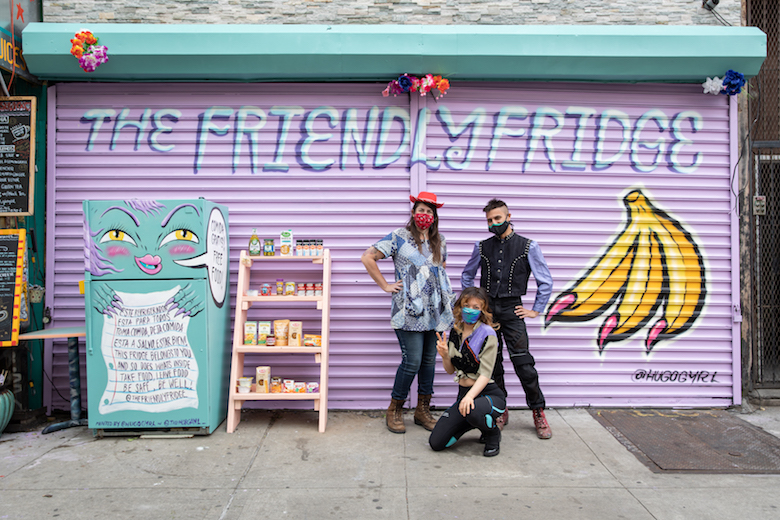
Back in February, the folks behind the anarchist community A New World In Our Hearts (ANWINOH) had a problem. As they were finishing up their free, weekly grocery pop up, Food Not Bombs, 12 boxes of produce arrived a little too late. Luckily, longtime organizer and member of the community Thadaeus Umpster had nabbed a free fridge off of Craigslist to help store items for the week (and to help declutter his fridge for the sake of his roommates). But as fate would have it, the fridge didn’t fit in his doorway. Using an extension cord, he stationed the fridge outside his building, stocked it with the fresh produce, and adorned it with a sign that said ‘Free Food’ before snapping a picture for Instagram. Within a few hours, the fridge was half empty. When the pandemic started a month later, he was flooded with DMs from people asking how to start their own.
“That was like an ‘aha’ moment; it was actually an alarming thing. Like, oh, wow, the need is greater than I imagined,” said Umpster.

According to the Food Bank for New York City, over 1.2 million people, or 14.4%, of New York City residents are food insecure. But due to the damaging effects of the COVID-19 pandemic, by May, that statistic had ballooned up to 2 million, translating to 1 out of 4 New Yorkers. With government assistance programs like unemployment stalling out, thousands turned to food pantries to feed themselves and their families. However, this safety net became even more exhausted, with food pantries claiming a state of emergency this past April. As lines began to spill across multiple blocks, longtime Harlem resident and community activist Sade Akin Boyewa El took a page from ANWIOH and started the first community fridge in Manhattan, the Harlem Community Fridge, to offer assistance.
“There’s a really twisted food culture in America. There’s shame involved in poverty, it’s frowned upon. If you don’t have funds, you end up having to stand on the line outside to a food pantry; a lot of people don’t want to be seen doing that. Having a free-standing community fridge that is accessible 24/7 where there are no questions are asked, you don’t have to fill out a form, [and] you can come and access it whenever you need, I think, for many, is the best option.”

Though community fridges are not an entirely new concept as it rose to acclaim in Germany back in 2014, the trend has truly taken hold in New York, as evident by the 32 fridges that have sprung up in Brooklyn, Queens, Staten Island, and even Albany. The fervor has caught fire across the country with fridges appearing in Nashville, Miami, Seattle and even with a few fridges making international debuts in Canada and Ecuador, all guided by Umpster.
The model of the community fridge is simple: take what you need, regardless of circumstance. The set up is easy too; many fridges are acquired free of charge thanks to Craigslist. As for power, activists only need to find a friendly bodega or restaurant and ask for a charge. For what’s inside, that varies depending on the fridge. Boyewa El’s fridge has seen the likes of root vegetables such as kale and bulbs of garlic alongside bagels and pastries from independent bakers and bakeries. A handful of fridges are accompanied by pantries stacked with canned soups, beans, and dried pasta. Volunteers have often shopped at the fridge and returned with cooked meals for the taking. Even a frozen turkey was donated to the Bed Stuy fridge. Embraced by the community, a few fridges have undergone makeovers like the teal splashed, Pee Wee Herman-esque fridge in Bushwick courtesy of HUGO GYRL.

These fridges also tackle one of the world’s largest problems: food waste. According to the USDA, 30-40 percent of the food supply goes to waste each year. With the disruption of the food supply chain due to the shuttering restaurants, schools, and stores, tons of food was left to rot and even destroyed. Using Signal, an encrypted messaging app, a network of over 150 volunteers, cyclists, and drivers coordinate to save food—including pallets of milk, hundreds of pounds of plums, and a ton of potatoes, to name a few—from restaurants, grocery stores, and other established industry connects to then be distributed straight to the fridges.
But as things open up post-COVID and people begin to return to their busy lives, the question remains: Are these fridges sustainable? To live beyond this moment, Umpster encourages activists to strengthen their local ties so that each community can support one another.
“Right now we have a network with like 150 people on [the app] who are available or looking for drivers. But once people are busy with work, I don’t know how much we can rely on that in the future,” he continues, “We see community fridges as a way to build community to strengthen ties and bonds between neighbors. We’re encouraging people to reach out to grocery stores, restaurants, and any sort of food distribution places in their neighborhood and have that be a regular thing.”
Interested in learning more? Check out ANWIOH’s Instagram for information on how to support this initiative and find a fridge in your area.
All photos courtesy of Walter Wlodarczyk.



